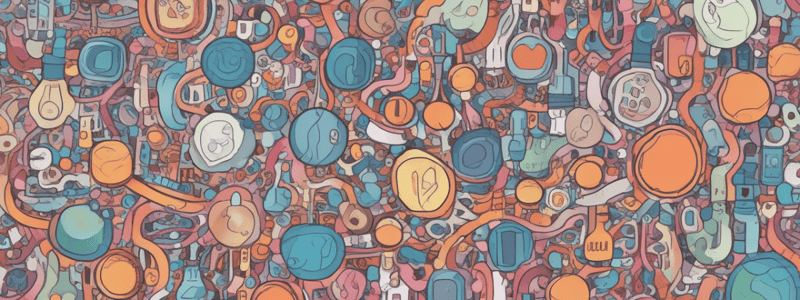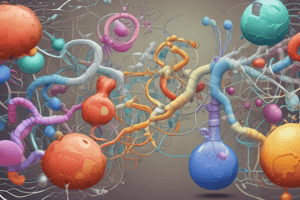Podcast
Questions and Answers
What is the function of glucuronyl transferase enzyme in the hepatocyte?
What is the function of glucuronyl transferase enzyme in the hepatocyte?
- To break down hydrogen peroxide in the RBCs
- To synthesize creatine phosphate in muscles
- To convert conjugated bilirubin to urobilinogen
- To attach glucuronic acid to bilirubin, forming conjugated bilirubin (correct)
What is the main function of glutathione in the body?
What is the main function of glutathione in the body?
- To provide defense mechanism against certain toxic compounds (correct)
- To activate some enzymes and inactivate insulin hormone
- To absorb amino acids in the gut
- To synthesize creatine phosphate in muscles
What is the product of glucuronic acid attachment to bilirubin?
What is the product of glucuronic acid attachment to bilirubin?
- Urobilin
- Urobilinogen
- Stercobilin
- Conjugated Bilirubin (correct)
What is the main site of creatine synthesis?
What is the main site of creatine synthesis?
What is the function of glutathione in RBCs?
What is the function of glutathione in RBCs?
What is the fate of majority of urobilinogen?
What is the fate of majority of urobilinogen?
What is the structure of glutathione?
What is the structure of glutathione?
What is the role of creatine phosphate in muscles?
What is the role of creatine phosphate in muscles?
What is the function of creatine phosphate in muscles?
What is the function of creatine phosphate in muscles?
What is the function of creatine kinase enzyme?
What is the function of creatine kinase enzyme?
Which isoenzyme of creatine kinase is mainly found in heart muscle?
Which isoenzyme of creatine kinase is mainly found in heart muscle?
What is the end product of creatine metabolism?
What is the end product of creatine metabolism?
What is the normal range of plasma creatinine?
What is the normal range of plasma creatinine?
What is the precursor for Tyrosine in the liver?
What is the precursor for Tyrosine in the liver?
What is the deficiency of phenylalanine hydroxylase enzyme?
What is the deficiency of phenylalanine hydroxylase enzyme?
What is the characteristic sign of Phenylketonuria?
What is the characteristic sign of Phenylketonuria?
What is the primary method for diagnosing phenylketonuria in infants?
What is the primary method for diagnosing phenylketonuria in infants?
Which of the following conditions is characterized by a deficiency of homogentisate oxidase enzyme?
Which of the following conditions is characterized by a deficiency of homogentisate oxidase enzyme?
What is the primary treatment for hereditary tyrosinemia?
What is the primary treatment for hereditary tyrosinemia?
Which of the following is a common consequence of alkaptonuria?
Which of the following is a common consequence of alkaptonuria?
What is the approximate frequency of phenylketonuria in live births?
What is the approximate frequency of phenylketonuria in live births?
What is the recommended duration for dietary restrictions in individuals diagnosed with phenylketonuria?
What is the recommended duration for dietary restrictions in individuals diagnosed with phenylketonuria?
Which of the following enzymes is deficient in albinism?
Which of the following enzymes is deficient in albinism?
What is the primary characteristic of acute hereditary tyrosinemia?
What is the primary characteristic of acute hereditary tyrosinemia?
What physiological function is associated with glycine?
What physiological function is associated with glycine?
What is the first product formed when glycine reacts with Succinyl CoA?
What is the first product formed when glycine reacts with Succinyl CoA?
How much bilirubin is produced daily from the degradation of hemoglobin in adults?
How much bilirubin is produced daily from the degradation of hemoglobin in adults?
What percentage of bilirubin is derived from hepatic turnover of hem proteins?
What percentage of bilirubin is derived from hepatic turnover of hem proteins?
What is biliverdin converted to during the degradation of heme?
What is biliverdin converted to during the degradation of heme?
Which of the following proteins bind unconjugated bilirubin in the liver?
Which of the following proteins bind unconjugated bilirubin in the liver?
What happens to released iron after the oxidation of heme?
What happens to released iron after the oxidation of heme?
What is the lifespan of red blood cells in the human body?
What is the lifespan of red blood cells in the human body?
Study Notes
Conversion of Amino Acids to Specialized Products
- Glycine is a non-essential glucogenic amino acid that serves as a precursor for various nitrogen-containing compounds.
- Glycine is converted to:
- Haeme (combines with globin protein to form hemoglobin)
- Hippuric acid
- Glutathione
- Glyoxylic acid
- Purine bases
- Bile salts
- Collagen
- Creatine
- Serine
- Neurotransmitter
Haeme Metabolism
- Haeme is degraded to bilirubin, which is produced daily in adults (250-400 mg).
- 70-80% of bilirubin comes from degradation of haemoglobin, while 20-25% comes from hepatic turnover of haem proteins.
- The life span of red blood cells is approximately 120 days.
- Senescent red blood cells are phagocytosed by cells of the reticuloendothelial system (spleen and liver).
- Haem is oxidized by the haem oxygenase system, releasing ferric iron (Fe3+) and carbon monoxide (CO).
- Biliverdin is reduced to bilirubin by biliverdin reductase.
- Unconjugated bilirubin is transported to the liver, where it is bound to albumin and then conjugated with glucuronic acid.
- Conjugated bilirubin is water-soluble and travels down the GI tract.
Glutathione
- Glutathione is a tripeptide formed from glutamate, cysteine, and glycine.
- It exists in two forms: reduced (G-SH) and oxidized (G-SS-G).
- Functions of glutathione include:
- Defense against toxic compounds (detoxification)
- Absorption of amino acids
- Protection against cell damage and hemolysis of RBCs
- Activation of some enzymes
- Inactivation of insulin hormone
Creatine
- Creatine is synthesized from glycine, arginine, and methionine in the kidney, liver, and pancreas.
- Functions of creatine:
- Creatine is phosphorylated to creatine phosphate in muscles.
- Creatine phosphate acts as a store of high-energy phosphate in muscles and is used during muscle exercise.
- Creatine kinase enzyme (CK) catalyzes the formation of creatine phosphate.
- There are three isoenzymes of CK: CK-MM (skeletal muscles), CK-MB (heart muscle), and CK-BB (brain).
- Creatine phosphate is degraded to creatinine, which is excreted by the kidney in urine.
- Diagnostic importance of creatinine:
- Estimation of plasma creatinine is used as a kidney function test.
- High blood creatinine and urea levels are sensitive indicators of renal failure.
Phenylalanine Metabolism
- Phenylalanine is a ketogenic and glucogenic essential amino acid.
- Functions of phenylalanine:
- Precursor for tyrosine in the liver
- Deficiency of phenylalanine hydroxylase enzyme or dihydrobiopterin reductase results in phenylketonuria (PKU).
- Effects of PKU:
- Mental retardation
- Increased blood phenylalanine
- Failure to walk and talk
- Hyperactivity and tremors
- Failure to grow
- Skin lesions (eczema)
- Frequency of PKU: 1 in 10,000 live births
- Diagnosis of PKU: measurement of blood phenylalanine by the Guthrie test in infants at 4 days old
- Prevention of PKU: feeding infants with PKU a diet containing very low levels of phenylalanine
Hereditary Tyrosinemia (Tyrosinosis)
- Definition: inability to metabolize tyrosine and p-hydroxyphenylpyruvate
- Cause: deficiency of tyrosine α-Ketoglutarate transaminase and p-hydroxyphenylpyruvate oxidase enzymes
- Forms of tyrosinemia: acute (death from liver failure within 7 months) and chronic (liver cirrhosis and hepatic carcinoma, mild mental retardation)
- Prevention and treatment: feeding a diet containing very low levels of tyrosine and phenylalanine
Alkaptonuria
- Definition: benign disease resulting from deficiency of homogentisate oxidase enzyme
- Effects:
- Deposition in joints causing arthritis
- Deposition in connective tissue causing generalized pigmentation
- Excretion in large amounts in urine, which is oxidized in the air giving dark urine
Albinism
- Definition: hereditary deficiency of tyrosine hydroxylase enzyme in melanocytes
- Effects: defective synthesis of melanin pigments, affecting the eyes, skin, and hair
- Types of albinism:
- Ocular albinism
- Cutaneous albinism
Studying That Suits You
Use AI to generate personalized quizzes and flashcards to suit your learning preferences.
Related Documents
Description
This quiz covers the conversion of amino acids to specialized products, including glycine's role in producing haeme, hippuric acid, and other compounds with physiological functions.




